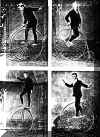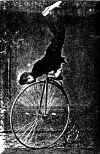Below is a copy of an article from the April, 1897 "The Home Magazine" published in Binghamton, New York. The pictures from the article are thumb nailed at the end of the article. Click on any picture for a larger view.
I have two bicycles and one unicycle that Mr. Hoefler used for his tricks. I also have 3 original pictures of Mr. Hoefler "trick riding" and one of his original riding outfits. The outfit is a gold silk outfit that reminds me a jockey uniform.
Click Here to view one of Mr. Hoefler's bikes
MODERN TRICK BICYCLE RIDERS
Concluding Paper
Of the many men who
learned to ride the old ordinary bicycle when it began to
become popular, in the years of 1879, 1880 and 1881, in but
a few were combined the natural aptitude, the energy and the
perseverance to make them famous, either as racers or as
trick riders. Of this latter class, many of the men who have
become great in their line acquired their first experience
in that period. It was in 1879 that Wilford H. Barber, of
trick-bicycle-rider-producing Rochester, first mounted a
wheel, and in the two or three years following he made no
little fame as a trick rider. It was in 1879 that Sid Black
began riding and W. S. Maltby became interested in fancy
riding, for his expertness in which he has become famous.,
during this
time period,
which also produced N. E. Kaufman, the winner of many
championship trophies, and Rexford M. Smith, who was the
first man to ride down the steps of the National Capital at
Washington. These riders and their feats have been the
subjects of the three preceding articles in this series.*
But not the least interesting of the events in fancy riding fWilliam C. Hoefler of Geneva, N.Y., at a little village called Phelps, in Ontario County, New York state. Geneva is notable and not alone as the birthplace of Mr. Hoefler, who began his life there February 18th, 1872. For Barber made his first appearance outside of his home city there, in 1883, after the youthful Hoefler had already achieved a local reputation as a rider. To return to Hoefler: He was an odd boy. His first mount came into his possession in 1880, and then, at the early age of eight, he began to do tricks. Trick riding must have been born in him, for it is chronicled he was consumed with a desire to shine as a fancy rider before he heard of such a thing as trick performing upon a wheel. For three months after he received his bicycle, he did not ride it out of his fathers yard. Hardly had he learned to propel his wheel in safety, when he began to practice at various mounts and dismounts, much to the peril of his neck.
"I allowed
nothing to discourage me," writes Mr. Hoefler, and therein
is found an explanation of his success, but not the only
one, for he worked hard. Road-riding had no charms for him.
He spent much of his time, sometimes ten or twelve hours a
day, climbing in and out of, over, under and through his
wheel, and at the end of the first three months he had a
very respectable repertoire of tricks. But he had one of
great difficulty. He could not perform his tricks with the
smoothness of routine that was required for a perfect act.
By giving his constant attention to this defect, he has
developed into the most finished of the trick riders - what
was his greatest obstacle has become a pedestal. When he
began to think that he was a really good rider, he went one
day to an exhibition given by Dan Canary, "the father of us
all," as Mr. Hoefler styles him. To use his own words, "I
was spellbound; it was a revelation to me." But he was not
one of the kind to be discouraged by anothers success, and
continued his hard practice.
Before Mr.
Hoefler was seventeen years of age he had an established
reputation, having appeared in public frequently with great
success. The managers of Barnum & Baileys big show heard of
him, and in 1889 made him an offer to go to London to
perform at the Olympia in their show for five months, at a
handsome salary with all expenses paid. It did not take him
long to accept the offer. Self-reliance was a characteristic
of the young man, and he was not held back by the thought of
a journey so far from home. His success in London was great.
The daring of the young rider, the novelty of his
performance attracted great crowds, and finally he was given
permission to perform before the royal family. Speaking of
this experience, Hoefler once said: " They applauded me just
like ordinary people. So many have asked me if I did not get
nervous on such an occasion that I will say, for their
benefit, that I was not a bit frightened." After his five
months contract with "the prince of humbugs," Mr. Hoefler
was engaged to appear successively at Paris, Berlin and St.
Petersburg, where he found the natives still talking of
Canary. But the young American gave them a new topic of
conversation. He returned from the old country after having
passed through all sorts of delightful experiences, and at
once took up exhibition work in this country, and the past
few years he has appeared in every state in the Union, in
Mexico, Central America and the West Indies.
His journeyings have been very extensive. In one fall and winter, from September to February, he traveled over 10,000 miles.
Mr. Hoefler has found his work profitable, and he had, what few boys would have had, the common sense to save his large earnings. When he celebrated his twenty-first birthday, he had a snug sum -$16,000- which represented his savings, stowed away, which was a very satisfactory showing. He always took great pride in his wheels, and they were marvels of workmanship and rare specimens of fine finish.
Mr. Hoefler has always been an originator of tricks. When he was crossing the ocean the idea came to him of taking his machine apart while riding, but he did not then develop the trick. He has since, however, performed the feat and considers it to be one of the most difficult in his repertoire - one that only a finished trick rider could do. Another trying trick is that of riding backwards on the ordinary with both wheels on the ground. This is another feat that Mr. Hoefler originated, and many of the great riders considered it impracticable. "My experience has been that it is many times more difficult than riding backwards on a safety," says he. But by far the hardest trick performed by the strong-nerved rider is the hand-stand on the saddle of his wheel, balancing it on two stools, which stand on a pyramid of three tables. Another of his accomplishments is to ride down a sixty foot ladder on a single wheel, which equals any other down-hill ride on record. Mr. Hoefler says that there is a great name awaiting the man who reduces trick - riding on the safety
to a science. Many showy and difficult tricks are done on a modern wheel, but there is still much to do before it is elevated to the plane to which riding on the ordinary has been raised.
This series of
articles could not with propriety be concluded without the
mention of Prince Wells of Louisville, Ky., who was formerly
one of the great riders of the high wheel, both as a racer
and a trick performer, and who is now a leading patron of
wheeling in the blue grass state. He too started his riding
career early in the eighties, and has successively been a
road-racer, and amateur on the track, and a professional
trick rider. He is now in the wheel business at his home,
and has been reinstated as an amateur by the League of
American Wheelmen.
The accompanying illustrations show Mr. Hoefler performing several of his most difficult feats, and preparing to do his dangerous hand-stand. An excellent likeness of Mr. Wells also accompanies the article, which concludes the series on "trick riders."
Harry Kenmore
*"Trick Bicycle Riders." January, 1896, dealing with Barber, Maltby, Black, Punnett and others; The Champion Trick Rider." February, 1896, describing N. E. Kaufmans achievements and "A Few More Masters of the Wheel" November 1896 being an account of the riding of Rexford M. Smith, Edward Kingsbury and Charles G. Kilpatrick.

